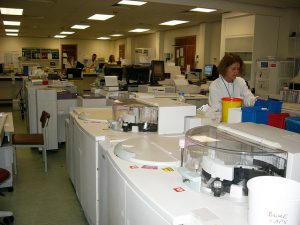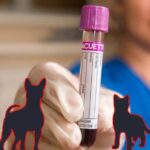Ron Hines DVM PhD


Go to this page first. Find the test(s) that interests you. Note the normal values for dogs or cats and compare it to the value in your pet. When you click on that test, it will take you to the proper explanation. For now, there are more tests discussed on the DxMe page than on the values page – with time, they should all appear on both.
I’ve written articles on some of the more common health issues of dogs and cats. Those appear as links in the article for each test. If I do not have an article to offer you, the link will send you to the best explanations I know of.
I tried to list the diseases that abnormal test result suggest more-or-less in the order of frequency with which I see them. That is never precise, and it is always subject to discussion. When I write “diabetes” I mean the pet equivalent of Type-2 diabetes in humans. If I mean another type of diabetes (D. insipidus) I will say so.
 How Concerned Should I Be If My Pet Has One Or Two Moderately Abnormal Lab Results?
How Concerned Should I Be If My Pet Has One Or Two Moderately Abnormal Lab Results?
You should be concerned enough to repeat the test(s) at a later date (~3-4 weeks) if your veterinarian does not have a reasonable non-health-related explanation for the unusual value. If the test was performed because of severe health changes, please do not wait that long. If the test(s) are still abnormal a second time (preferably on a different lab analysis machine), consider additional tests and procedures that examine the problem more deeply.
Minor high or low values can be of no significance (10-12% off normal), but they can announce the start of an organ problem that will increase or resolve with or without treatment. In some cases, they are related to the advancing age of your pet.
ERRORS OCCUR. Abnormal lab results need to be repeated and confirmed – preferably at a large veterinary testing laboratory. Your decisions always need to be made in light of your pet’s history and age, your veterinarian’s physical examination and the other clinical data that your veterinarian has accumulated.
How your dog or cat’s blood sample is collected and how it is handled after collection can cause errors in the results. Samples that are pink or red (hemolyzed) can give falsely high readings for ALT, AST, Creatinine, CK, Iron, LDH, lipase, Magnesium, Phosphorus, Potassium and BUN and falsely low readings for Albumin, ALP, Chloride, GGT, Glucose and Sodium.
 How Are Veterinary Laboratory Tests Divided?
How Are Veterinary Laboratory Tests Divided?
Veterinarians tend to study each of your pet’s organ systems through a group of tests or parameters that they consider as a group to determine where in the dog or cat’s body the problem is likely to be located, how serious the problem might be and what might be the underlying cause.
There is considerable overlap on the focus of specific tests, but here is the way I organize them in my mind. They could (and have) been grouped in a variety of different ways:
 Tests That Monitor The Acidity Status Of Your Pet’s Body:
Tests That Monitor The Acidity Status Of Your Pet’s Body:
Bicarbonate, Anion Gap, Blood pH, Blood Carbon Dioxide (CO2) Level
 Tests That Determine How Well Your Pet’s Adrenal Glands Are Working:
Tests That Determine How Well Your Pet’s Adrenal Glands Are Working:
Cortisol, Cortisol/creatinine ratio, low or high dose dexamethasone suppression test, ACTH stimulation test
 Tests That Determine How Well Your Pet’s Thyroid Gland Is Working:
Tests That Determine How Well Your Pet’s Thyroid Gland Is Working:
T4, T3, free T4 (two-step and equilibrium dialysis methods), thyroglobulin autoantibody (=TgAA)
detection, TSH level (in dogs = cTSH)
 Tests That Measure How Well Your Pet Is Metabolizing Sugar And Other Carbohydrates:
Tests That Measure How Well Your Pet Is Metabolizing Sugar And Other Carbohydrates:
Blood Glucose level, Fructosamine test, Glycosylated Hemoglobin.
 Tests That Measure Your Pet’s Blood Electrolyte And Mineral Status:
Tests That Measure Your Pet’s Blood Electrolyte And Mineral Status:
Blood Sodium, Potassium, Chloride. Calcium, Magnesium, Phosphorus and Bicarbonate
 Tests As To How Well Your Pet;s Immune System Is Working:
Tests As To How Well Your Pet;s Immune System Is Working:
Blood Globulin level, WBC count and Differential blood cell count, A/G ratio. Individual Immune or antibody titers (=antibody levels)
 Tests That Monitor The Status Of Your Pet’s Oxygen-carrying Red Blood Cells (Erythrocytes):
Tests That Monitor The Status Of Your Pet’s Oxygen-carrying Red Blood Cells (Erythrocytes):
PCV/hematocrit, hemoglobin, red cell morphology (= shape, & uniform size), reticulocyte count, MCV, MCHC
 Tests That Check Iron Availability:
Tests That Check Iron Availability:
Serum/plasma iron, total iron binding capacity (TIBC), % iron saturation of transferrin.
 Tests To Determine How Well Your Pet’s Kidneys Are Functioning:
Tests To Determine How Well Your Pet’s Kidneys Are Functioning:
Blood urea nitrogen (= BUN), creatinine, phosphorus, urine specific gravity, urine pH, urine protein content and/or microalbuminuria Some veterinarians have faith that the SDMA test provides useful information on kidney health as well.
Many of these urine tests also give veterinarians clues as to your pet’s hydration/dehydration status.
 Tests That Examine Fatty Substances (Lipid) Parameters In Your Pet’s Blood:
Tests That Examine Fatty Substances (Lipid) Parameters In Your Pet’s Blood:
 Tests That Determine How Well Is Your Pet’s Liver Is Working:
Tests That Determine How Well Is Your Pet’s Liver Is Working:
Enzymes that often “leak” during liver disease are: ALT, AP, AST, Albumin, SDH, LDH, GGT.
Tests that judge how well your dog or cat’s liver is performing its tasks also include : Bilirubin, Bile acids, Blood Ammonia
 Tests That Detect Inflammation, Autoimmune Disease and Infection:
Tests That Detect Inflammation, Autoimmune Disease and Infection:
C-reactive protein, White Blood Cell / WBC count, Sedimentation Rate, ANA / Coombs test
 Tests That Detect Muscle Damage:
Tests That Detect Muscle Damage:
Creatine kinase (= CK), AST, LDH, Myoglobin
 Tests That Check How Well Your Pet’s Pancreas Is Functioning:
Tests That Check How Well Your Pet’s Pancreas Is Functioning:
Amylase, Lipase, Trypsin-like immunoreactivity (=TLI), cPL, fPL
 Tests That Check Your Pet’s Blood Protein Levels:
Tests That Check Your Pet’s Blood Protein Levels:
Total blood protein /TP, albumin, immunoglobulins (among your pet’s blood proteins, albumin transports hormones, fatty acids, and other compounds, buffers blood pH, and maintains cellular pressure. It has other functions. The cat and dog’s immunoglobulins have critical functions in your dog or cat’s immune system in protecting your pet from infectious disease.)
 Tests That Examine Your Pet’s Hormonal Reproductive System:
Tests That Examine Your Pet’s Hormonal Reproductive System:
Blood progesterone level, blood estrogen level, GnRH levels, GnRH response tests, etc.
 Tests That Examine The Adequacy Of Your Dog And Cat’s Blood Coagulation (Clotting) System:
Tests That Examine The Adequacy Of Your Dog And Cat’s Blood Coagulation (Clotting) System:
Platelet count, clotting time, bleeding time, prothrombin time, coagulation time, coagulation on glass, thrombin clot time, aPTT, von Willebrand factor, blood fibrinogen level, D-dimer assay for evidence of DIC
DxMe



 How Concerned Should I Be If My Pet Has One Or Two Moderately Abnormal Lab Results?
How Concerned Should I Be If My Pet Has One Or Two Moderately Abnormal Lab Results? How Are Veterinary Laboratory Tests Divided?
How Are Veterinary Laboratory Tests Divided?